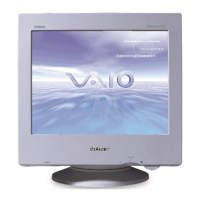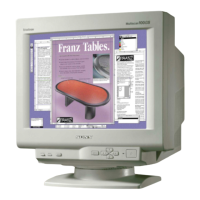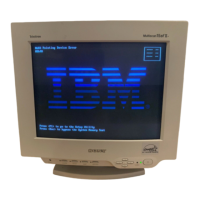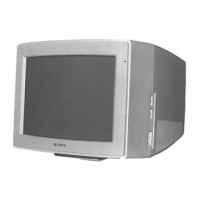
Do you have a question about the Sony Trinitron CPD-E215E and is the answer not in the manual?
| Screen Size | 21 inches |
|---|---|
| Display Type | CRT |
| Viewable Size | 19.8 inches |
| Max Resolution | 1600 x 1200 |
| Dot Pitch | 0.24 mm |
| Horizontal Refresh Rate | 30 - 96 kHz |
| Vertical Refresh Rate | 50 - 160 Hz |
| Aspect Ratio | 4:3 |
| Input Connectors | VGA (HD-15) |
Details on CRT pitch, viewable image size, resolution, and standard image area.
Information on deflection frequency, input voltage, power consumption, and dimensions.
Step-by-step safety checks to perform after service before releasing the unit.
Methodology and equipment for checking AC leakage from exposed metal parts.
Alerts regarding safety-critical components and proper replacement procedures.
Details on VESA, ENERGY STAR, NUTEK power-saving compliance and modes.
How to use the self-diagnosis function and interpret power indicator states.
Guidelines on power connections, installation, maintenance, and transportation.
Location and function of key controls, buttons, and connectors on the monitor.
Steps for connecting the monitor to a computer and initial configuration.
How to select the display language for the on-screen menu.
Guide to adjusting brightness, contrast, centering, and size using the control button.
Adjusting picture geometry, color temperature, and convergence for optimal display.
Configuring degaussing, moire cancellation, menu position, and control locking.
Tips for common issues, how to use the HELP menu, and resetting adjustments.
Information on preset/user modes and power saving functions.
Solutions for issues like no picture, distorted images, and on-screen error messages.
How to use the self-diagnosis function to identify monitor or computer issues.
Steps for removing the monitor cabinet and internal A/D boards.
Procedures for removing the picture tube and H board.
Diagram showing the location and routing of internal harnesses and cables.
Checks for HV regulator, HV protector, and beam current protector circuits.
Procedures for checking B+ voltage and beam protector software logic.
Steps for rough and fine adjustment of picture landing and convergence.
Adjusting vertical/horizontal position, size, and focus for optimal picture quality.
Overview diagrams for signal paths, frame schematics, and board locations.
Schematics for H board, A board, and D board (µ-COM, Deflection, HV, Power Supply).
Exploded diagram of the monitor chassis with part numbers.
Exploded diagram of the picture tube assembly with part numbers.
List and identification of packing materials used for shipping.
Comprehensive list of electrical components, part numbers, and descriptions.












